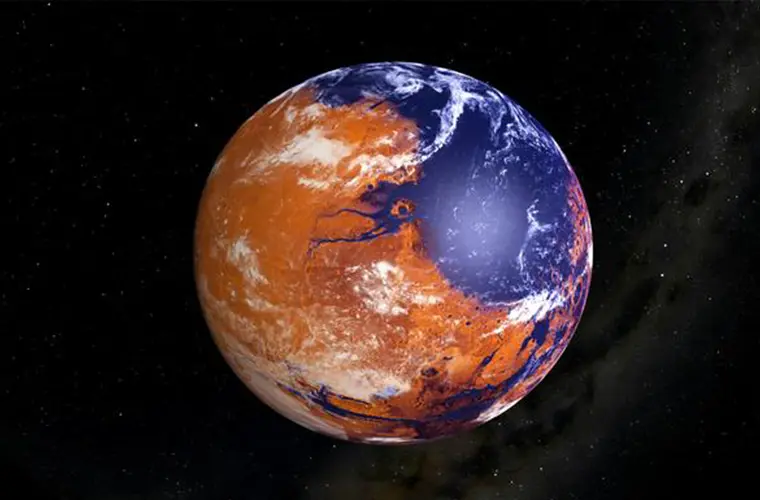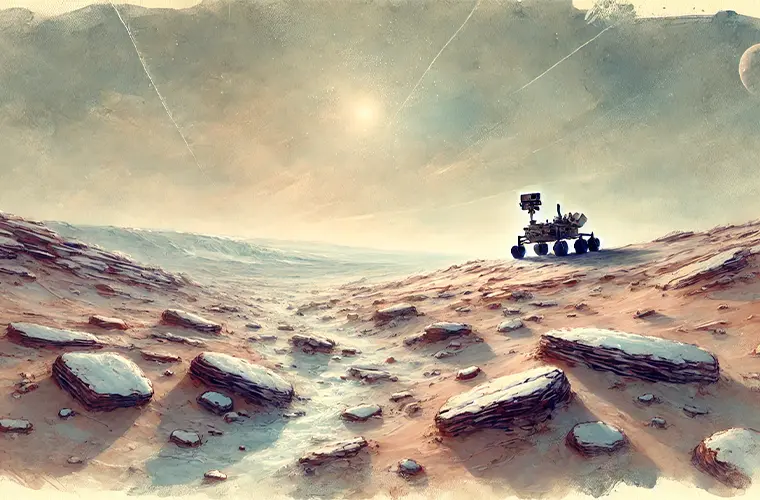NASA’s Curiosity rover is revealing new insights into how Mars, once a water-rich planet, became the dry uninhabitable world it is today.
According to NASA scientists, Mars’ atmosphere was stripped away over billions of years by solar winds, extreme climate shifts involving intense evaporation, and cold, salty conditions, leaving the Red Planet inhospitable to life as we know it.
New discoveries by Curiosity are providing valuable insights into Mars’ ancient climate and offers significant clues about the planet’s potential to have once-supported extraterrestrial life.
The findings, published in Proceedings of the National Academy of Sciences, are based on isotopic measurements of carbonates from Gale Crater. These minerals, formed during Mars’ ancient past, provide valuable insights into the planet’s climatic evolution.
Earlier research suggests that about 2 billion years ago, Mars had a much denser atmosphere, which could have supported liquid water on its surface. This environment might have allowed rivers and lakes to form across the planet.
However, according to lead study author Dr. David Burtt from NASA’s Goddard Space Flight Center, analysis of the isotope values in the carbonates collected by the Curiosity rover suggests that water likely only existed on Mars in short, fleeting intervals. These findings rule out the possibility of a stable, long-lasting environment for life on the Martian surface.
“The isotope values of these carbonates point toward extreme amounts of evaporation, suggesting that these carbonates likely formed in a climate that could only support transient liquid water,” Dr. Burtt explained in a press release by NASA. “Our samples are not consistent with an ancient environment with life (biosphere) on the surface of Mars, although this does not rule out the possibility of an underground biosphere or a surface biosphere that began and ended before these carbonates formed.”


Researchers are particularly interested in studying Martian isotope values and carbonates because these minerals serve as reliable climate records. Scientists can gain insight into ancient Martian environments by examining how different isotopes of carbon and oxygen accumulated in carbonate rocks.
These carbonates preserve information about the conditions in which they formed, such as water temperature, acidity, and the atmospheric composition at the time. This helps researchers piece together Mars’ climatic history and evaluate whether it ever had conditions favorable for life.
NASA researchers have proposed two possible climate models for ancient Mars by analyzing carbonates collected near Gale Crater. One model suggests that Mars experienced wet-dry cycles, allowing brief periods of habitability. The other theory points to extremely salty, cryogenic conditions where life would have faced significant challenges.
Both scenarios, however, describe environments far more extreme than Earth’s, making it difficult to sustain life as we know it, further complicating the planet’s history of potential habitability.
“These formation mechanisms represent two different climate regimes that may present different habitability scenarios,” Dr. Jennifer Stern of NASA Goddard, a co-author of the paper, explained. “Wet-dry cycling would indicate alternation between more-habitable and less-habitable environments, while cryogenic temperatures in the mid-latitudes of Mars would indicate a less-habitable environment where most water is locked up in ice and not available for chemistry or biology, and what is there is extremely salty and unpleasant for life.”
Researchers believe the latest findings provide strong evidence that solar winds—high-energy particles from the sun—played a significant role in Mars’ atmospheric loss. Over time, these winds stripped away the planet’s atmosphere, which once protected liquid water and possibly microbial life.
NASA’s data shows that Mars’ magnetic field, which shielded its atmosphere, weakened significantly, allowing solar winds to deplete essential molecules like hydrogen and oxygen. Without these elements, the planet’s atmosphere thinned, temperatures dropped, and water either evaporated or froze, transforming Mars into the desolate world we see today.
Mars’ smaller size and weaker gravity made it less capable of retaining its atmosphere, unlike Earth, which has a strong magnetic field and a thicker atmosphere to resist solar winds.
Researchers highlighted that the unusually high carbon and oxygen isotope values on Mars suggest an extreme environmental process. “While evaporation can cause significant oxygen isotope changes on Earth, the changes measured in this study were two to three times larger,” Dr. Burtt said.
This indicates that Mars experienced severe water loss, leading to heavier isotope values being locked into carbonate rocks. Preserving these heavy values implies that processes typically responsible for lighter isotopes played a much smaller role, reinforcing the study’s findings of Mars’ drastic climate shifts.
NASA’s research has implications beyond Mars. Understanding how planets lose their atmospheres can inform the study of other celestial bodies, including exoplanets outside our solar system.
For NASA, these findings are especially significant as the agency ramps up efforts to explore Mars more extensively in the coming decades, including the highly anticipated goal of sending humans to the Red Planet.
The recent revelations also provide critical context for the upcoming Mars Sample Return Mission, a collaboration between NASA and the European Space Agency. This mission will bring soil and rock samples from Mars back to Earth for more in-depth study, potentially revealing more about the planet’s geological history and climate evolution.
NASA scientists are particularly interested in studying whether remnants of Mars’ ancient atmosphere or trapped water molecules could still exist deep below its surface. If such evidence is found, it could reignite hopes that microbial life once existed—or could still exist in some form—on Mars.
Beyond the technical achievements, this discovery rekindles one of humanity’s oldest questions: Are we alone in the universe?
Given its early similarities to Earth, Mars has long been considered one of the most promising places to search for signs of life. However, these new findings suggest that even billions of years ago, life as we know it was unlikely to have existed there.
The extreme environmental conditions, including intense evaporation and harsh, cold, salty environments, would have made Mars far less hospitable than previously thought, reducing the chances of stable, life-supporting ecosystems developing.
Nevertheless, understanding Mars’ drastic environmental change could offer lessons about planetary evolution, including Earth’s climate challenges.
Additionally, the insights gained from Curiosity’s mission could prove vital for the ongoing search for life beyond Earth. By revealing how extreme environmental conditions can shape planetary habitability, scientists can refine their strategies for detecting life-supporting environments on other planets and moons.
Ultimately, these findings provide a more detailed framework for exploring celestial bodies that may harbor life or once had the necessary conditions, guiding future missions searching for signs of extraterrestrial life.
Tim McMillan is a retired law enforcement executive, investigative reporter and co-founder of The Debrief. His writing typically focuses on defense, national security, the Intelligence Community and topics related to psychology. You can follow Tim on Twitter: @LtTimMcMillan. Tim can be reached by email: tim@thedebrief.org or through encrypted email: LtTimMcMillan@protonmail.com

